I had owned a Ruger Redhawk in the past, but it was sold during hard times. It was one of those revolvers that I regretted selling, but I could not live in it, drive it, or eat it so it had to go. Mine, unlike the 4.20-inch barreled model shown below, was the 7.50-inch barreled model in blued steel. It was a gorgeous piece.

Earlier this year (2019), my local range and gun club put several of their range rental guns up for sale. A Ruger Redhawk in .44 Magnum with a 4.20” barrel was one of those revolvers along with a Smith and Wesson Model 686, which had come home with me a week earlier.
Firing a 240 gr (16 g) JHP Cor-Bon round results in roughly 1,475 ft/s (450 m/s) at the muzzle with 1,160 foot-pounds of energy, or when firing the Federal 240 gr. Hydra-Shok JHP, 1251 fps out of the 4″ barrel is quite possible (source: Ballistics By The Inch). Regardless, there is a whole lot going on when the hammer falls on a magnum cartridge. Of course, .44 Special cartridges can be fired from the same revolver and a Cor Bon 200-grain DPX round is good for a quite docile 972 feet per second. Considering that the same Ruger Redhawk in .45 Colt chambering can send a Cor Bon 200-grain JHP +P downrange at 875 feet per second out of the same length barrel, an additional 100 feet per second from a .44 special is still pale compared to the .44 Magnum loading.
It had been many years since I fired a .44 magnum in both single- and double-action platforms. At 48 ounces (3 pounds), the Ruger Redhawk with a 4.20” barrel is no lightweight, but that weight is needed to help tame the recoil the .44 Magnum round can generate with this short barrel. A 9mm cartridge (124 grain) traveling at approximately 1124 feet per second at the muzzle can generate around six foot-pounds of recoil energy. A .44 Magnum (240 grain) traveling at 1239 feet per second at the muzzle can generate 11.9 to 12.4 foot-pounds of recoil energy. That’s roughly 16 feet per second coming back at the shooter (source: Chuck Hawks Handgun Recoil Table).
Lest I digress further, let’s get back to the Ruger Redhawk itself.
The Redhawk, introduced in 1980, was a scaled-up and improved version of the Security-Six, the target model, with a square butt grip, adjustable sights, and 5.5- and 7.5-inch barrel lengths. The 4.20-inch barreled version was introduced later (according to https://en.wikipedia.org/wiki/Ruger_Redhawk it was to satisfy the Canadian rules for minimum barrel length), and this is the version that was offered at my range and gun club.
One advantage of range rental revolvers is that they are shot less often than semi-automatic handguns. We did have one case of a Ruger Redhawk going out of time, but that was not this revolver. People shoot the Ruger Redhawk for two reasons; neither of which is for pleasure. Curiosity for one and experimentation for the second. Some folks have never fired the .44 Magnum and want to see what one is like to shoot. Hand loaders like to experiment, and it is a whole lot better to experiment on somebody else’s gun than your own, since those who ‘roll their own’ sometimes have the propensity to load on the hot side.
This example of the Ruger Redhawk has a few scratches from normal wear and tear of being a range rental. But being a stainless-steel firearm, some polishing and buffing can wear down all but the deepest scratches. I did not buy it as a show piece anyway, but it does have to be mechanically sound.
The ‘Hawk’ was, of course, filthy when I brought it home (see below). The cylinder face had probably never been cleaned and it was the first to come under attack. Using some Wilson Combat carbon remover, a chemically-treated cloth, and a bronze brush, the remains of who knows how many rounds was removed from the cylinder face and forcing cone area.

Surprisingly, the bore was clean, perhaps cleaned by one of the range employees; nevertheless, it was scrubbed with Hoppe’s and was soon in fit condition. Next, the grip was removed, and the entire revolver received a thorough wipe down.
The grip was swapped with a Hogue® Monogrip® that was larger and provided more area for the hand to grip. The Hogue® Monogrip®; however, proved actually to be too big for my hand. The finger grooves positioned my hand way too low on the back strap, as I like as high a grip as possible, especially with the high bore axis of the Ruger Redhawk.
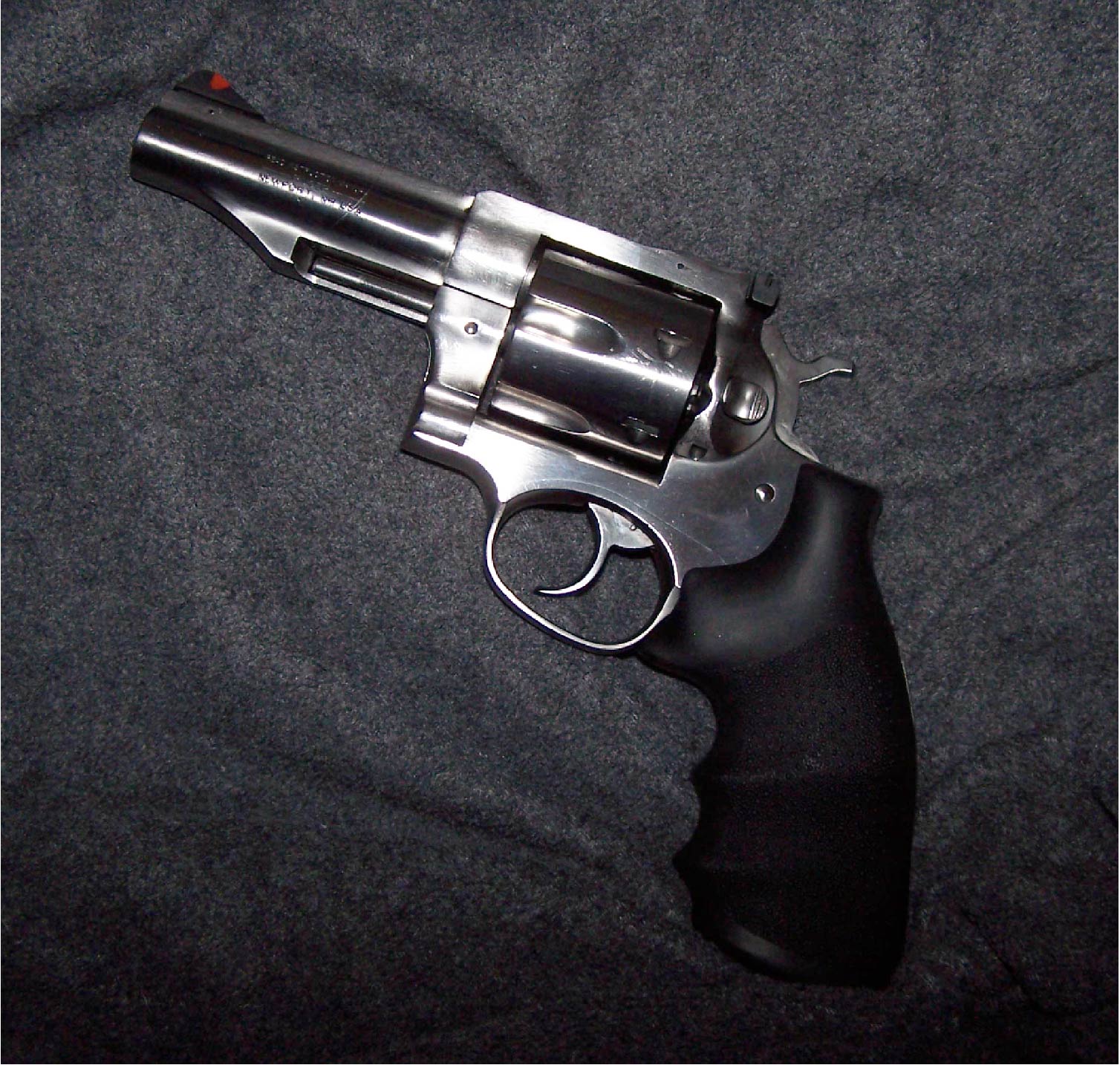
Although I do like the Hogue® Monogrip® with its finger grooves and energy absorbing material, the Ruger Redhawk Square Classic Panel Super Rosewood Checkered from Altamont Grip (shown below) sure enhances the looks of the ‘Hawk.’ They look great especially in their ‘SilverBlack’ version against the stainless-steel of the ‘Hawk.’ Besides, a good pair of shooting gloves would aid more in mitigating the effects of recoil than with just the Hogue grip.


The sights are in excellent condition. The revolver has forward ramp sights with four different interchangeable sight inserts (available through Ruger). The rear sights are fully adjustable, featuring a white outline. The ‘flash gap’ was checked and fell within my desired 0.004-inch gap. The timing and lock-up was checked and I saw no problems with that.
The double-action pull is, of course, heavy but very smooth. The ‘staging’ of the trigger in a Ruger revolver has always been one of my favorites over any revolver. Pull back the trigger until you feel slack (you will also hear a click as the cylinder locks into place). This is the ‘staging point.’ From this point, it is only a slight pull until the hammer falls. This ‘staging point’ provides a means to perform a final sight picture before committing to firing the revolver, or if desired, a point to decide not to shoot. With practice, finding the ‘staging’ point becomes second nature. I have always liked the ‘staging point’ of the Smith and Wesson revolvers, but it is much more pronounced and desired in the Ruger DA revolvers. The objective during the double-action pull is to maintain the same sight picture throughout the pull stroke. The ‘staging point’ is just a check point on the way through the journey.
The single-action pull is almost non-existent. In single-action mode, the only job for the trigger is to drop the hammer, and it does that job very well.
Range Day
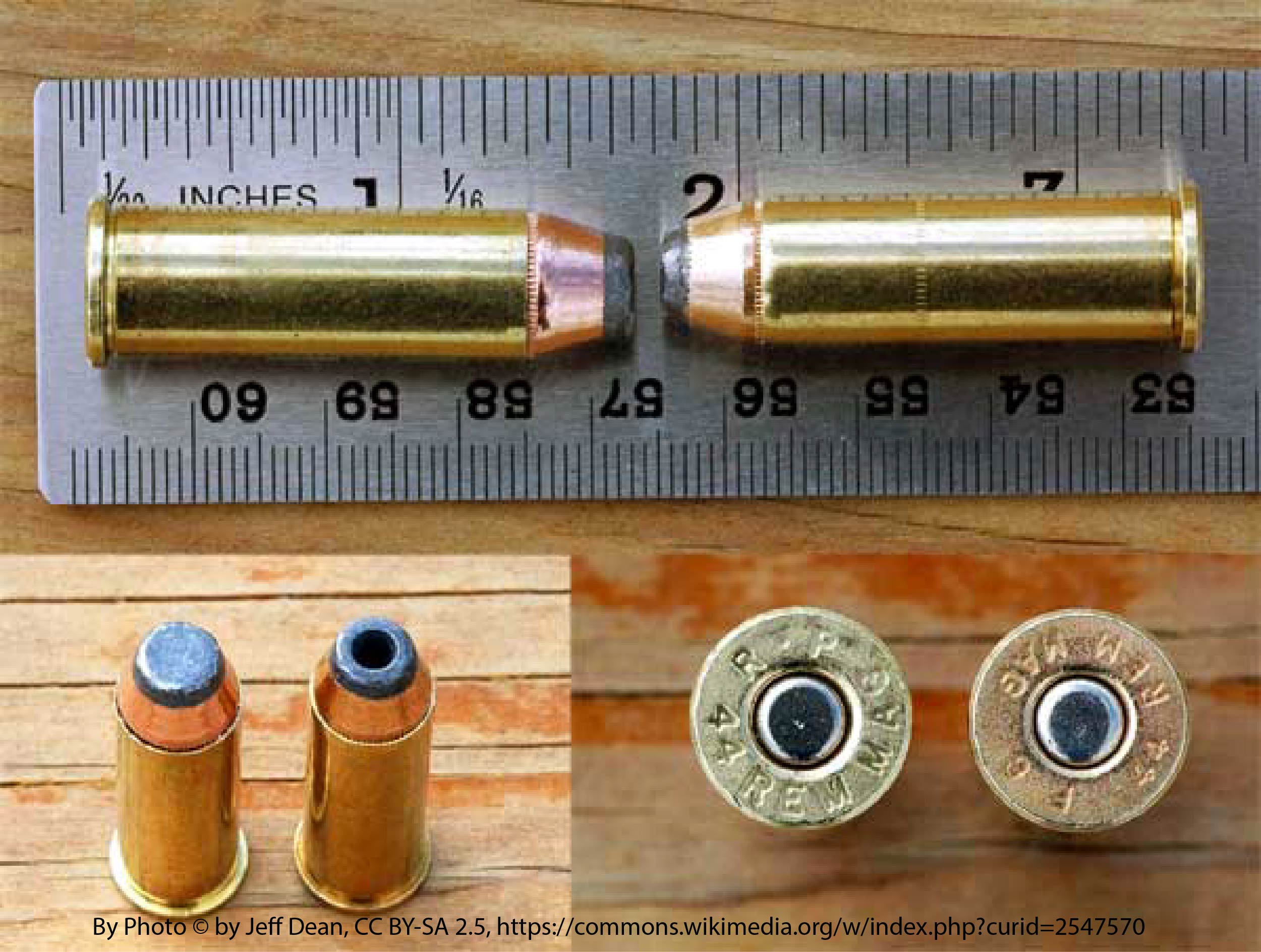
I was not going to spend a lot of time, or money, slinging lead from the ‘Hawk.’
The Sig Sauer V-Crown 240-grain JHP (above) traveling at about 1300 feet per second would make a good personal defense load, if accurate through the ‘Hawk.’
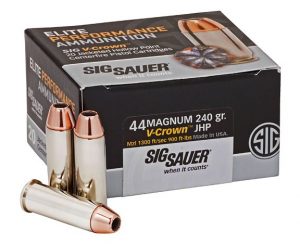
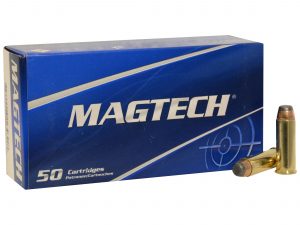
Magtech Sport Ammunition 44 Remington Magnum 240 Grain Semi-Jacketed Soft Point (shown above) traveling at 1180 Feet Per Second at the muzzle would make a good; albeit, expensive range load. Since I don’t hunt, I am not interested in personal thermo-nuclear ammunition. I am getting too old for shooting that heavyweight stuff, anyway. Something that can be used for practice and defense is preferable. As I have said, I don’t have range ammunition, I have ammunition that I shoot at the range.
I know that it would be cheaper to shoot .44 Special at the range, but I prefer that magnum-length loads be fired through a magnum revolver.
Muzzle blast, side-flash, and recoil are just three of the things that make the Ruger Redhawk .44 Magnum revolver, and in fact any .44 Magnum revolver, a not so enjoyable experience unless you are masochistic person.
Given the above, and if you can keep from flinching, the Ruger Redhawk is surprisingly accurate. This day, I was simply checking for function and any possible problems. The target was at ten yards, or one-tenth of the distance the .44 Magnum is effective. I was shooting from my usual modified Weaver stance at first, but switched to a modified Isosceles stance about four rounds in. If I kept my wits about me and concentrated on the shot rather than the effect of the shot, I could pull of some decent six-shot groups. Note that MPBR (Maximum Point Blank Range) of a .44 Magnum 240-grain bullet traveling at 1172 feet per second is approximately 120 yards with a 100 yard zero. Near zero is +1.6 at 25 yards.
The 4.20” barrel contributed to some of the recoil; whereas, the 7.5” barrel is somewhat more forgiving, but not by much.
The ‘thumb-over’ method did help in controlling some of the effects of the recoil and in trying to keep the muzzle down as much as possible. The .44 Magnum recoil is stout, but it is manageable with good shooting techniques and a good pair of shooting gloves. The ‘thumb-over’ method also help to keep the support hand away from the ‘flash gap’ (the front of the cylinder) that, especially in the case of the .44 Magnum, could do some serious damage to the hand.
While I do enjoy the Ruger Redhawk, I am still partial to the Super Blackhawk when shooting .44 Magnum cartridges. I like the way the Super Blackhawk single-action revolver rolls in the hand instead of a straight back and up recoil path of the Redhawk.
Concealment
I am sure that there are ways to conceal this monster, but it begs the question; Why? Without going into why the .44 Magnum revolver is not a good firearm to conceal there may be time and situations where it may be necessary. Carrying something this huge on the hip is maybe for somebody of greater body mass and strength than I. I could possibly pull off a shoulder holster carry in the colder Georgia season, but carrying three pounds plus of revolver is no picnic – and I can see no reason to carry this beast in an urban setting when my 1911 will do just fine, thank you.
I can see carrying the Ruger Redhawk in a ‘Chesty Puller”’ system under a large coat in Bear country (or other locale with animals that can eat you). However, I think that with a high-ride pancake style of OWB holster, I could pull off concealed carry of this revolver since the barrel is only 4.20 inches. With the Sourdough Pancake™ holster (shown below left) from Simply Rugged Holsters, set up with the ‘Inside The Waistband Straps,’ or a A113 Caracara IWB holster from FALCO Holsters (shown below center), or the FALCO A112 Falcon holster (shown below right). I do believe that I could effectively conceal the Ruger Redhawk with the 4.20” barrel, because I have successfully concealed the Ruger GP100 in the same holster worn IWB. With this old body; however, my support system (suspenders) would be a definite must.

In the case of a large revolver like the Ruger Redhawk, and in the field, I think that it is more of a choice of protecting the firearm rather than concealing the firearm. In the field, I say carry however is convenient and that works; strong side, cross-draw, shoulder holster, chest holster, whatever.
Summary
The .44 Magnum cartridge is a powerful cartridge. It is not as powerful as some, but it is powerful enough to take down some serious game through the right firearm. The Ruger Redhawk is one of those firearms.
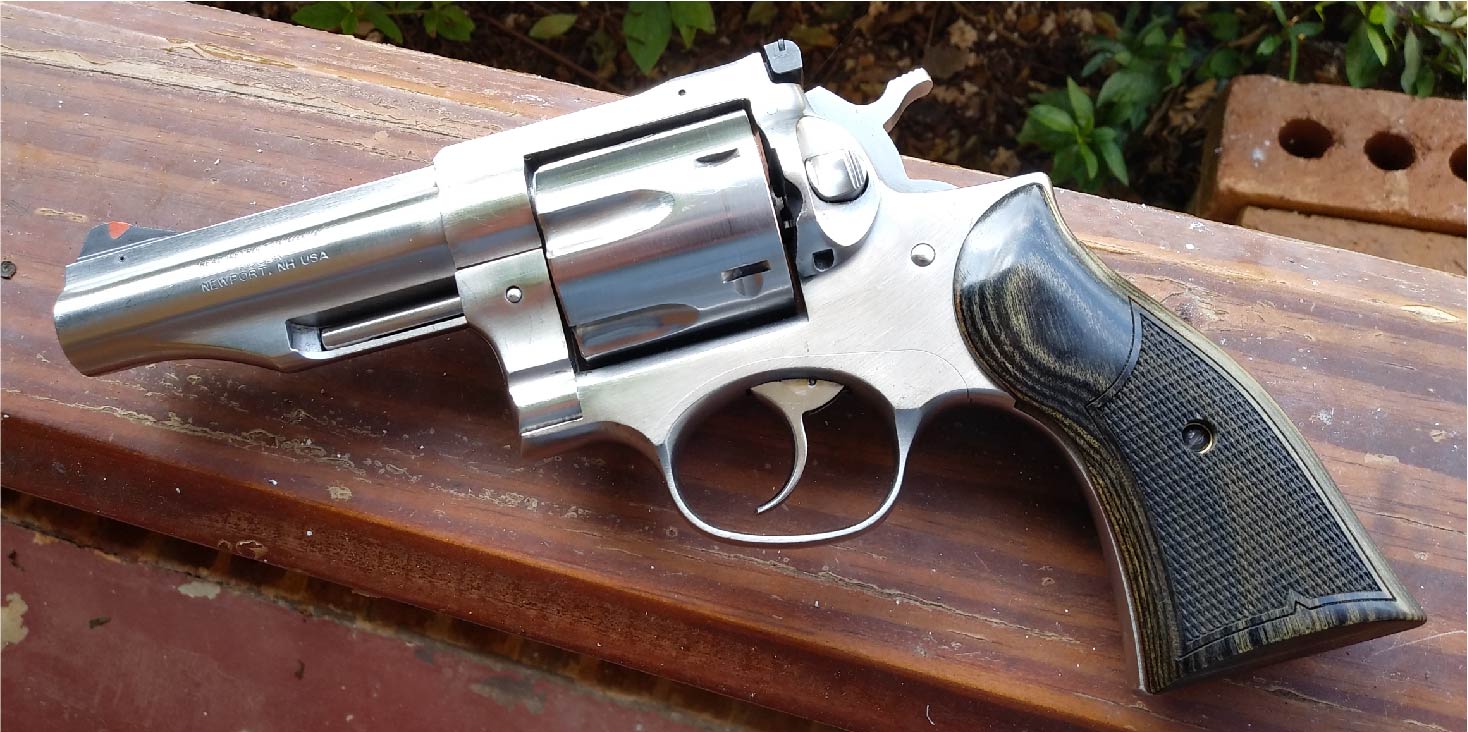
The Redhawk was the first large-bore double-action revolver made by Ruger. Pair this up with a Ruger M77 bolt-action carbine in .44 Magnum and you have one heck of a woods-walking pair.
With the 7.5-inch barreled version, you have a formidable hunting tool. With the 4.2-inch barrel, the Federal 240-grain Hydra-Shok JHP can produce a velocity of 1251 feet per second; however, through a 7-inch barrel that same round can produce a velocity of 1462 feet per second, and that is a significant increase.
The .44 Magnum cartridge is as big as I need to go, as I get older and wiser. I need a most excellent firearm to shoot it through and the Ruger Redhawk and Ruger Super Blackhawk are the two firearms that I trust explicitly to do the job.
With that said, Ruger’s 45 Auto/45 Colt Redhawk double action revolver is chambered to shoot both .45 Auto and .45 Colt cartridges and ships with three (3) full moon clips that act as both a speed loader for the .45 Auto rounds and aid in the ejection of the spent cartridges. Aside from the 45 Auto/45 Colt version, the Ruger Redhawk is also chambered in .357 Magnum and .41 Magnum.
Resources
Ruger Redhawk: https://ruger.com/products/redhawk/models.html
Ruger Redhawk 4.2″ .44 Magnum – My woods Howitzer: https://www.youtube.com/watch?v=Sjy6Kda92NE
![]()

